2.6 Behavior of tidal streams
Tidal streams vary in strength according to the shape of the coastline and the seabed topography. With practice, it is possible to guess where the strong streams will occur and where the streams will be less strong, or eddies will form.
Flow tends to be weak close to the shore and stronger offshore. Flow at headlands that project into the tidal stream and squeeze it can be strong. Especially strong flows can occur in narrow channels between islands.
The flow of tidal streams is similar to that of a river, but on a much larger scale. Tidal flows tend to go in straight lines over long distances, taking lots of space to turn corners. An abrupt corner in a coastline will hence usually have an eddy behind it, where the flow is weak and may even be in the opposite direction to the main stream.
The map below show some of the local tidal stream effects that occur on the North Coast of Anglesey:
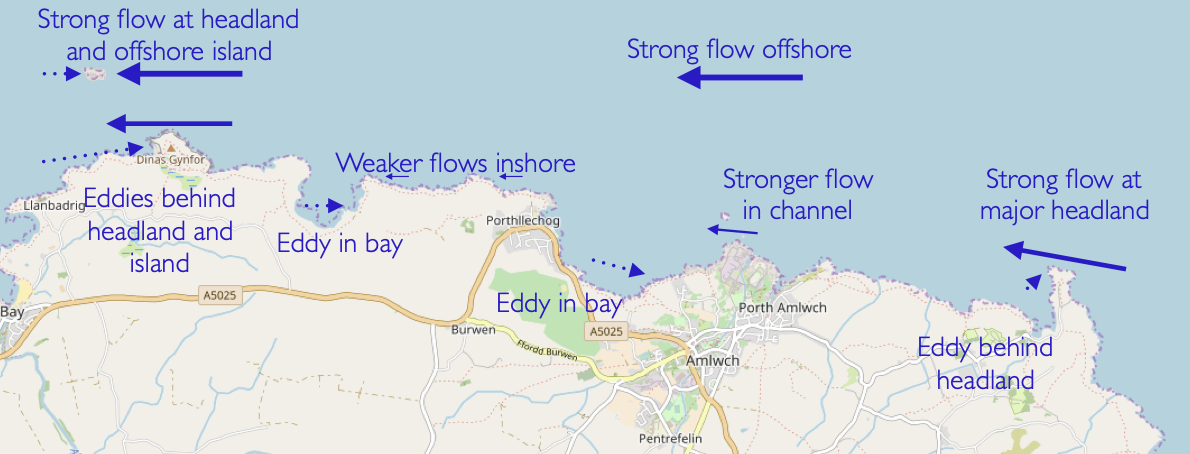
Local tidal stream effects that occur on the North Coast of Anglesey
Anglesey sits at the NW corner of Wales. The tidal flow is concentrated here, as the water rushes around this corner towards Liverpool.
Zooming out and looking at Anglesey with a flood tide, it should be no surprise that the fastest flows are found at the major headlands on the N and NW side of the island and in the narrow part of the straits that separate the island from Wales.
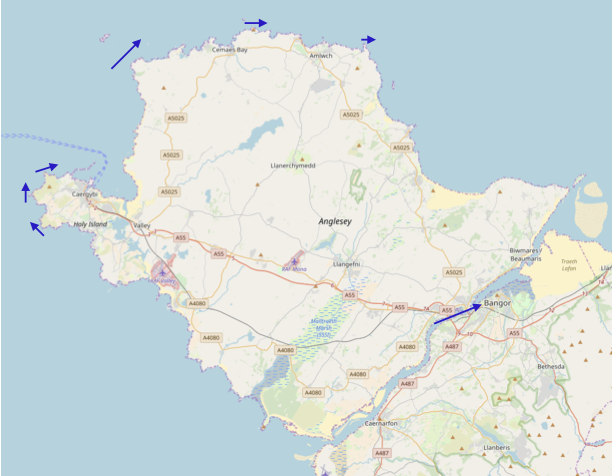
Locations of fastest tidal stream flows around Anglesey
A range of information sources about tidal streams exist. The main sources are:
- Tidal diamonds (and the associated tables) on charts
- Tidal stream atlases
- Pilots and guidebooks
Each type of source presents the information in a different way, so we’ll consider them one by one in the sections that follow.
2.6.1 Races and overfalls
If the tidal stream is squeezed into a smaller channel, it will speed up. This can occur in two ways:
The tidal stream can be squeezed sideways - perhaps into a narrow channel between islands, or by a headland protruding from the coastline:
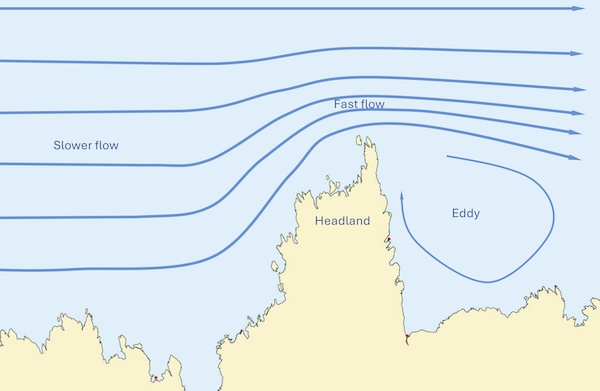
The area of fast flowing water here is known as a tide race.
The tidal stream might be squeezed vertically by an area of shallow seabed, or a reef:
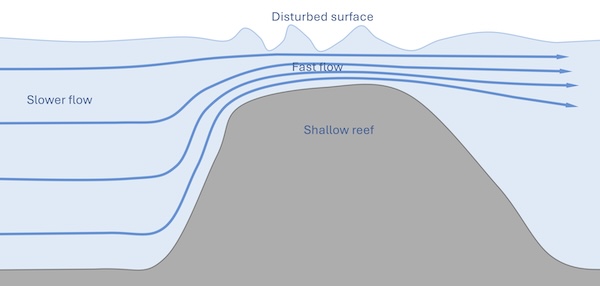
In this case, the area of fast flowing water is called an overfall.
Identify races and overfalls in the area around Bardsey Sound
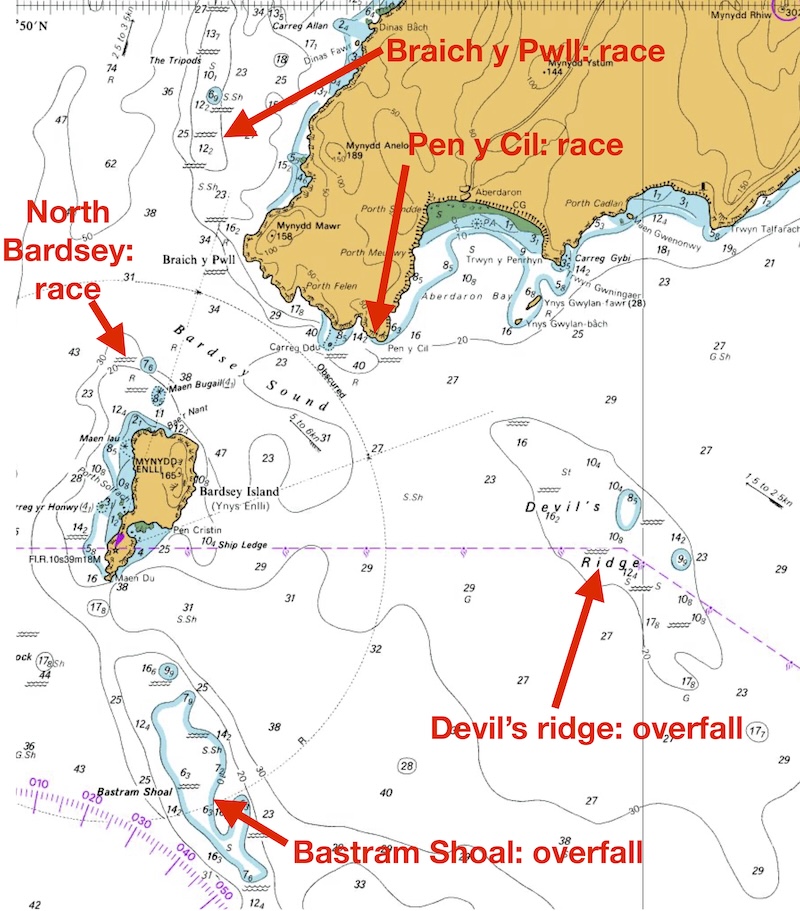
Bardsey sound is at the tip of the Lleyn Penninsula, a long finger of land sticking out into the sea. We shouldn’t be surprised that the tidal streams are strong at the end of such a big headland.
The chart makes it easy to see where major races and overfalls occur - they’re marked with wiggly lines that look like waves.
Two areas of shallows where overfalls form are marked: The Devil’s Ride and the Bastram Shoal. The tide speeds up over these shallow reefs, often causing a confused sea state.
There are a number of races marked around Bardsey sound where land squeezes the tidal stream - at the north end of Bardsey, at Pen y Cil and at Braich y Pwll. Notice how long the race at Braich y Pwll is - as the fast-flowing tide leaves Bardsey Sound and runs north, it takes a long time to slow down.
Note that it’s unlikely that all the races and overfalls that might affect a sea kayak are marked on a chart. For example, a challenging tide race can form at Maen Du at the sound end of Bardsey Sound. Although there’s nothing marked here, we might reasonably expect a race to form at such a sharp point given how fast the tide flows in this area.
In practise, there’s not a lot of difference between races and overfalls - many headlands have shallow areas extending out the sea, so that the tide is squeezed by horizontally and vertically. Many paddlers will use the terms ‘race’ and ‘overfall’ interchangeably.
Races and overfalls present a number of hazards to kayakers:
The boundary between the fast flow and adjacent slow flowing eddies can form a sharp ‘eddyline’ that can spin and capsize the inexperienced.
Turbulence as the flow accelerates, and especially as it decelerates, can form steep waves and boils.
When waves and wind move in the opposite direction to a tidal stream, larger and steeper waves will form - more on this in the notes on waves.
Of course, those with appropriate skills and experience often seek out these conditions for training and enjoyment!
The Falls of Lora is a tidal overfall that forms at the narrow entrance to Loch Etive (so, in some sense, it’s also a race). The image below shows the Falls during the flood tide:
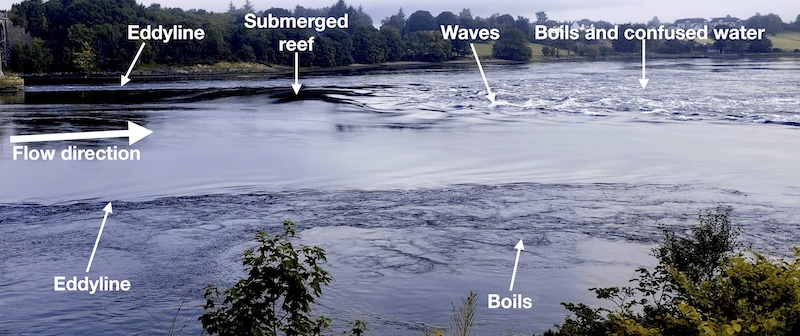
This overfall forms in sheltered wave, so it is rarely affected by sea state - the features are simply due to the fast flowing water.
Notice that the flow is smooth in the area where it is accelerating - all of the turbulence occurs down tide of the reef where the water is losing energy and slowing down.
It’s hard to get a sense of scale from the image - it’s likely that the largest waves in this image are a little over a meter high.